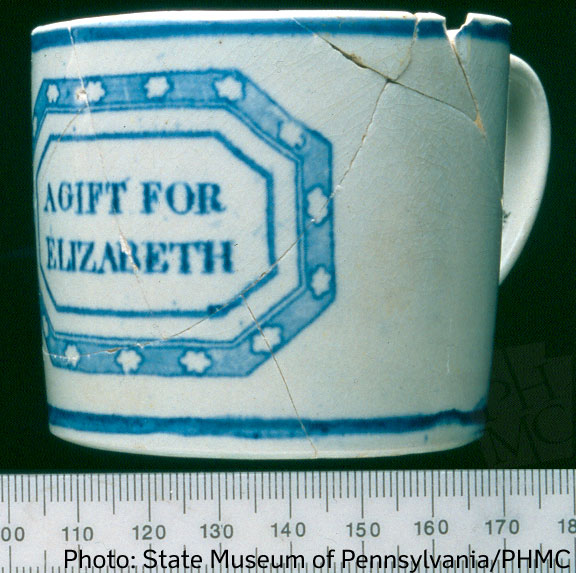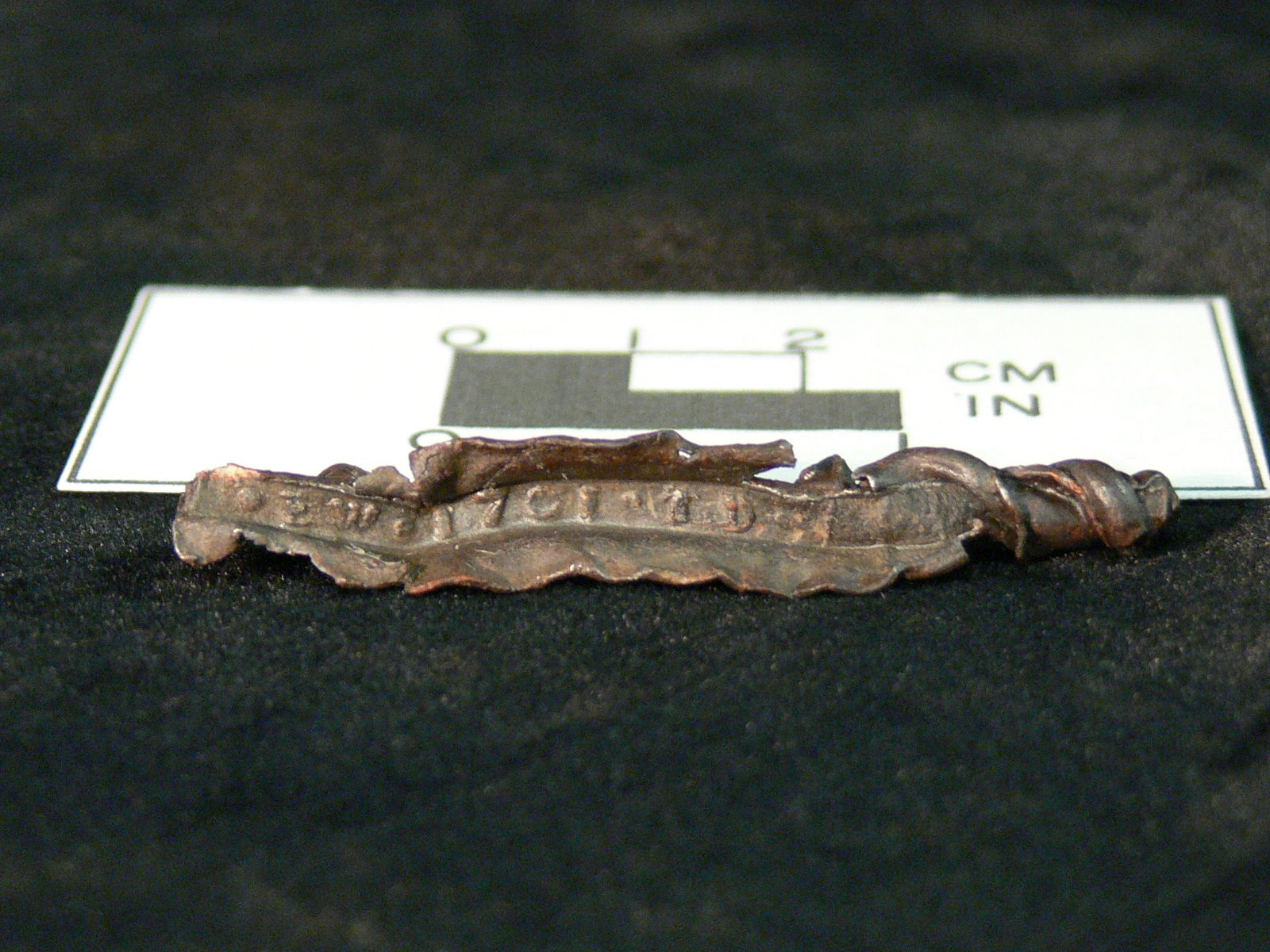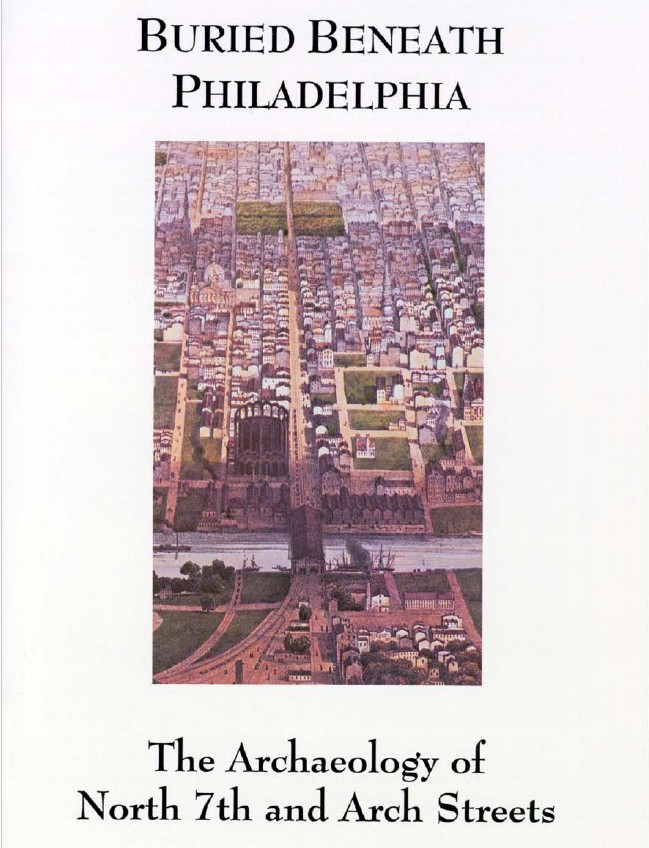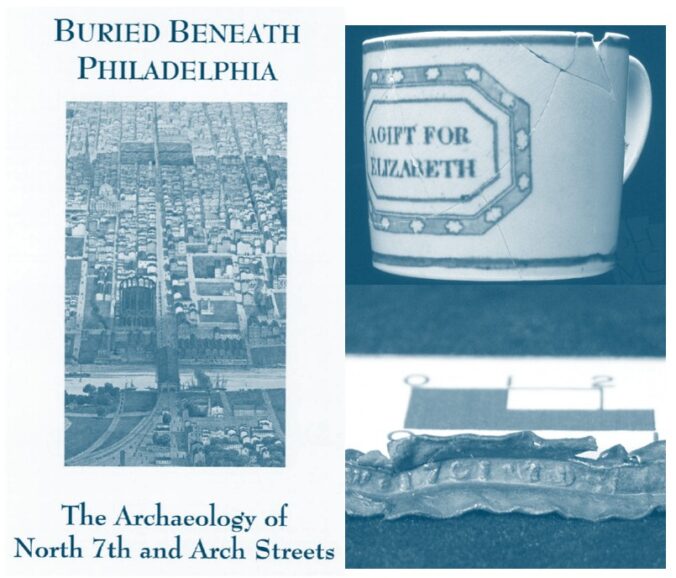In the 1990s, a federal construction project for a new detention center in Philadelphia resulted in the identification of an urban archaeological site in the area of North 7th and Arch Streets.
The archaeological excavations of the site focused on uncovering foundations and associated items of historic interest within a series of early lots that fronted both streets. The North 7th and Arch streets project area was designated Site 36PH91, meaning the site is the 91st site (91) recorded in Philadelphia County (PH) in the Commonwealth of Pennsylvania (36).
Below is a little bit about two finds from that site – a child’s ceramic mug and a piece of window lead.
Children’s Ceramic Items
Louis Berger and Associates, Inc. discovered this pearlware child’s mug during the excavation of Feature 19, for the Metropolitan Detention Center (36PH0091). Feature 19 is a brick lined shaft located at the rear of 702 Arch Street, possibly the remains of a privy.

Early 19th century printed children’s mug.
The available census records place Charles Clayton and his family at 700/702 Arch Street from 1804 until 1818. Artifact dates from this feature suggest that the Clayton household was responsible for its fill. In 1810 theses same records list the occupants of the Clayton household as Charles, his wife Eleanor, three girls, one boy and five men. Unfortunately the records do not list the first names of the Clayton children but it is believed that the mug may have been a gift for one of the daughters.
During the early nineteenth century there was an increase in the production of ceramic items specifically manufactured for the children of the more affluent middle class.
18th Century Window Lead
Archaeologists often comment about discoveries being made in the lab, long after the actual digging of a site has ended. They also lament that practice of archaeology in many cases poses more questions than it answers. This artifact is a prime illustration of both phenomena.
Excavated by Louis Berger Group, Inc. from the Metropolitan Detention Center Site (36Ph91) at 7th and Arch Streets in Philadelphia prior to the construction of a federal prison, this artifact is a fragment of window lead, also called turned lead. Originally H-shaped in cross section, it would have held individual panes of glass together to form a complete window. Correctly identified by Berger staff, it was not until the collection was submitted to the State Museum of Pennsylvania’s Section of Archaeology for curation that the discovery of a date flanked by two pairs of initials stamped on the inside channel was made. In the image “EW 1701 TD” can clearly be seen.

Fragment of window lead from 36PH0091.
Other instances of window lead with dates and initials have been found at archaeological sites such as Jamestown, Flowerdew Hundred, and Williamsburg. Closer to Philadelphia, excavations in Trenton at the Lambert/Douglas House conducted by Hunter Research, Inc. prior to highway improvement construction also yielded fragments of window lead, at least one of which bore initials and a date. Incredibly, the initials and date on the fragment from the Lambert/Douglas House are identical to those found on the fragment from the Metropolitan Detention Center Site.
Unfortunately, neither the individual artisan/tradesman nor the manufacturer have yet to be identified. Nevertheless, these two finds, and their undeniable relationship to each other, open the door for questions and discussion concerning the manufacture of and distribution systems for building materials (and other goods) relatively early on in the European colonization of America and the permanent settlement of the lower Delaware River valley more specifically.
For additional information regarding window lead see Flowerdew Hundred by James Deetz, A Guide to Artifacts of Colonial America by Ivor Noel-Hume, and History traced by Route 29 – A Tale of Two Houses by Ian Burrow.
TWIPA Connection
The “Children’s Ceramic Items” content was previously published on the “This Week in Pennsylvania Archaeology” (TWIPA) blog on February 27, 2009. The “18th Century Window Lead” content was previously published on the TWIPA blog on April 10, 2009. Both have have been reposted here without modification.
Learn More!
If you would like to learn more about the Metropolitan Detention Center (36PH0091), check out the Buried Beneath Philadelphia: The Archaeology of North 7th and Arch Streets pamphlet. The pamphlet was prepared as part of the mitigation plan for the site by the project consultant.

Public information pamphlet prepared by project consultant as part of the mitigation plan for the detention center construction.
Comment Policy
PHMC welcomes and encourages topic-related comments on this blog. PHMC reserves the right to remove comments that in PHMC’s discretion do not follow participation guidelines.
Commenters and Comments shall be related to the blog post topic and respectful of others who use this site.
Commenters and Comments shall not: use language that is offensive, inflammatory or provocative (this includes, but is not limited to, using profanity, obscene, or vulgar comments); disparage other commenters or people; condone illegal activity; identify the location of known or suspected archeological sites; post personal information in comments such as addresses, phone numbers, e-mail addresses or other contact details, which may relate to you or other individuals; impersonate or falsely claim to represent a person or an organization; make any commercial endorsement or promotion of any product, service or publication.
If you would like to comment on other topics not related to this blog post but related to PHMC, please fill out the PHMC Contact Us Form.

Leave a Reply